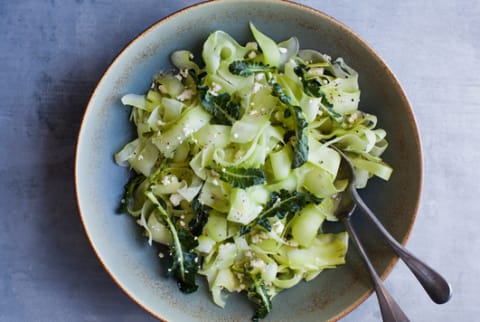Advertisement


Today, gluten-free chef and author Phoebe Lapine shares her tips for reducing food waste at home. For more great ideas check out her MBG video course: How To Make Delicious And Healthy Meals On A Budget And In A Time Crunch.
Like many people, I’m always trying to live a greener life. But when it comes to daily waste, especially in New York City with an absence of compost bins and backyard gardens, a lot of it inevitably comes from my kitchen.
In recent years I’ve been trying to change my habits to make the most of the ingredients I buy and help keep needless trash to a minimum. Even when I’m harried and trying to get dinner on the table, I try to remember that our individual food losses have a role in worldwide hunger. And if we cut that waste in half, it would go a long way to closing the gap in food needs.
As Dana Gunders writes in Waste-Free Kitchen Handbook, “No matter how organically or sustainably we grow our food, if it doesn’t get eaten, it doesn’t do anyone any good.”
I’ve learned that you don’t have to be a frontierswoman or die-hard DIY-er to make use of the small food scraps that might otherwise amount to a much larger pile by the end of the week. If you’re driven by budget, these recipe ideas might just help your dollar stretch further. And either way, delicious things are sure to result.
1. Recycled Veggie Stock
Every part of the vegetable contains flavor, even if it’s not necessarily the most pleasant part to munch on. Since much of our food waste comes from the prepping process, I use a bowl to collect any compostable scraps—fennel fronds, carrot peelings, garlic skins, herb stems, etc.—as I slice and dice.
At the end of my cooking session, I add those scraps to a Ziplock bag (or glass Tupperware) and store them in my freezer. At the end of the month (or sooner!), you can dump all those magical bits and pieces into a giant pot and make your next month’s worth of veggie stock.
Not only will you be saving vegetables that would have otherwise ended up in the trash, but you’ll be making something for free that you might have otherwise bought!
Try this recipe for Indian-Spiced Recycled Veggie Broth.
2. Asparagus-Stalk Pesto
Asparagus spears have a natural breaking point where the woody stems become tender. You can trim them by gently holding both ends and snapping the stalk in half—it will usually break about ¾ of the way down.
Most people throw away the tougher pieces, but you can easily use them up by making a flavorful asparagus pesto. Simply blanch the stalks in boiling water until vibrant and tender, then puree in a food processor with lemon juice, garlic, nuts, and whatever wayward herbs you have lying around.
I like using radish leaves for even more waste-free brownie points. If that seems like too much fuss, recycled veggie stock it is.
3. Lemon-Garlic Wilted Greens
When you buy greens at the grocery store—especially if they come in those plastic clamshells—they can turn from leafy and beautiful to a soggy mess fairly quickly.
The sour smell may cause your nose to wrinkle, but I promise you that all is not lost. A little garlic and some intentional wilting can go a long way to making those sad bruised greens not just palatable, but delectable.
Sauté a clove of thinly sliced garlic in hot olive oil until lightly browned and fragrant, then add your greens. This works particularly well for spinach, arugula, and especially beet greens, which often look a little rough before you even get them home.
Finish the sauté with a squeeze of lemon juice to add brightness.
4. Pickled Stems + Rinds
Pickling is an excellent way to not only preserve, but tenderize parts of the plant that you wouldn’t ordinarily eat. Brine chopped chard stems this way and you have a great crunchy topping for salads or grains.
Pickled watermelon rinds can add a little sour pop to a sweet dish, or a hint of sweetness to something savory.
5. Candied Citrus Peel
If you’re not using up your citrus peel by zesting the bajeezus out of it (and adding to salt or sugar!), another great way to reuse them is by making candy.
The syrup that results from simmering the peel in sugar water can be used to flavor cocktails. As for the candied peels themselves, try adding them to dark chocolate bark, granola, or just simply enjoy on their own.
6. Fennel Frond Bouquets
This might not be an edible tip, but I love the way fennel fronds look and smell when set in a vase on the countertop. If you buy veggies from the farmer’s market, your fennel may have an especially impressive herby stalk emerging from its crown.
Cut it off at the bulb and stick in water. You can use the fronds to accent existing flower arrangements, or just grab at them from time to time to finish a dish with a little anise-y flavor.
7. Desperation Soup
My uncle is a classic over-buyer at the farmer’s market. His countertops are always lined with bowls of the season’s most beautiful bounty. That is, until the following Saturday arrives and the lot is looking slightly less enticing compared to all the new shiny produce that’s begging to be purchased.
His solution? Desperation soup. Throw in everything but the kitchen sink—and even your recycled veggie broth if you have any. Add some legumes or grains and you’ll have a well-balance bowl full of beautiful veggies before they even have a chance to make it fully past their prime.
My minestrone soup is a great base to throw in whatever you have on hand.